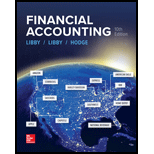
1.
Provide
1.
Explanation of Solution
Journal:
Journal is the method of recording monetary business transactions in chronological order. It records the debit and credit aspects of each transaction to abide by the double-entry system.
Accounting rules for journal entries:
- To record increase balance of account: Debit assets, expenses, losses and credit liabilities, capital, revenue and gains.
- To record decrease balance of account: Credit assets, expenses, losses and debit liabilities, capital, revenue and gains.
Prepare journal entry for the deposit in savings account at the end of Year 1:
| Date | Account Titles and Explanation |
Debit (Amount in $) |
Credit (Amount in $) |
| Savings Account | 2,000 | ||
| Cash | 2,000 | ||
| (To record the cash deposited made in savings account at the end of Year1) |
(Table 1)
- Savings account is an asset and there is an increase in the value of an asset. Hence, debit the savings account by $2,000.
- Cash is an asset and there is a decrease in the value of an asset. Hence, credit the asset by $2,000.
2.
Identify the balance in the savings account at the end of 10th year.
2.
Explanation of Solution
Future value:
The future value is value of present amount compounded at an interest rate until a particular future date.
Annuity:
An annuity is referred as a sequence of payment of fixed amount of
Determine the balance in the savings account at the end of 10th year:
Therefore, the balance in the savings account at the end of 10th year is $30,386.
3.
Identify the interest earned on the 10 deposits.
3.
Explanation of Solution
Identify the interest earned on the 10 deposits:
Therefore, the total interest earned on the 10 deposits is $10,386.
4.
Calculate the amount of interest revenue the fund earned in second year and in third year.
4.
Explanation of Solution
Calculate the amount of interest revenue the fund earned in second year:
Calculate the amount of interest revenue the fund earned in third year:
Therefore, the amount of interest revenue earned during the second year is $180 and third year is $376.
5.
Prepare journal entries at the end of second and third year for the deposit made in savings account.
5.
Explanation of Solution
Prepare journal entry to record entries at the end of the second year:
| Date | Account Titles and Explanation |
Debit (Amount in $) |
Credit (Amount in $) |
| Savings Account | 2,180 | ||
| Cash | 2,000 | ||
| Interest revenue | 180 | ||
| (To record the interest revenue earned end of second year) |
(Table 2)
- Savings account is an asset and there is an increase in the value of an asset. Hence, debit the savings account by $2,180.
- Cash is an asset and there is a decrease in the value of an asset. Hence, credit the cash by $2,000.
- Interest revenue is a component of
stockholder’s equity and there is an increase in the value of revenue and equity. Hence, credit the interest revenue by $180.
Prepare journal entry to record the entries at the end of the third year:
| Date | Account Titles and Explanation |
Debit (Amount in $) |
Credit (Amount in $) |
| Savings Account | 2,376 | ||
| Cash | 2,000 | ||
| Interest revenue | 376 | ||
| (To record the interest revenue earned at the end of third year) |
(Table 3)
- Savings account is an asset and there is an increase in the value of an asset. Hence, debit the savings account by $2,376.
- Cash is an asset and there is a decrease in the value of an asset. Hence, credit the cash by $2,000.
- Interest revenue is a component of stockholder’s equity and there is an increase in the value of revenue and equity. Hence, credit the interest revenue by $376.
Want to see more full solutions like this?
Chapter 9 Solutions
Financial Accounting
- General accountingarrow_forwardDon't use ai given answer accountingarrow_forwardMoonWear, Inc. offers an unconditional return policy. It normally expects 2.5% of sales at retail selling prices to be returned before the return period expires. Assuming that MoonWear records total sales of $12.5 million for the current period, what amount of net sales should it record for this period?arrow_forward

 AccountingAccountingISBN:9781337272094Author:WARREN, Carl S., Reeve, James M., Duchac, Jonathan E.Publisher:Cengage Learning,
AccountingAccountingISBN:9781337272094Author:WARREN, Carl S., Reeve, James M., Duchac, Jonathan E.Publisher:Cengage Learning, Accounting Information SystemsAccountingISBN:9781337619202Author:Hall, James A.Publisher:Cengage Learning,
Accounting Information SystemsAccountingISBN:9781337619202Author:Hall, James A.Publisher:Cengage Learning, Horngren's Cost Accounting: A Managerial Emphasis...AccountingISBN:9780134475585Author:Srikant M. Datar, Madhav V. RajanPublisher:PEARSON
Horngren's Cost Accounting: A Managerial Emphasis...AccountingISBN:9780134475585Author:Srikant M. Datar, Madhav V. RajanPublisher:PEARSON Intermediate AccountingAccountingISBN:9781259722660Author:J. David Spiceland, Mark W. Nelson, Wayne M ThomasPublisher:McGraw-Hill Education
Intermediate AccountingAccountingISBN:9781259722660Author:J. David Spiceland, Mark W. Nelson, Wayne M ThomasPublisher:McGraw-Hill Education Financial and Managerial AccountingAccountingISBN:9781259726705Author:John J Wild, Ken W. Shaw, Barbara Chiappetta Fundamental Accounting PrinciplesPublisher:McGraw-Hill Education
Financial and Managerial AccountingAccountingISBN:9781259726705Author:John J Wild, Ken W. Shaw, Barbara Chiappetta Fundamental Accounting PrinciplesPublisher:McGraw-Hill Education





